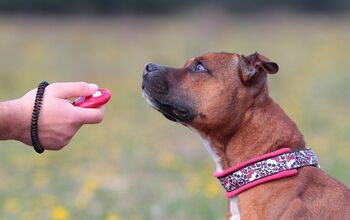6 Easy Ways to Train Your Dog Every Day

Many people assume that once a dog graduates from the puppy phase, your job in training him is finished. In reality, training is a lifelong pursuit for dogs and their owners. Once your dog masters the basics of obedience training you won’t have to review those basic skills often, but you do need to keep working with your dog to reinforce his training and to keep his mind sharp.
To assume that at a certain point the training is complete and you never have to think about it again is a mistake. Training a dog is a lifelong commitment. Sure, this process will evolve and change. Sure, it won’t be as intensive as it is in the beginning because your dog will reach a point at which they no longer constant reinforcement. But that doesn’t mean that the process is over. It’s simply evolved.
So, how do you continuing training in a more subtle matter as your pup matures? Well, you’ve come to the right place to find out. Continue reading and all will be revealed…
How Much Time Should You Spend on Training Each Day?
When your dog is still a puppy, you should expect to spend a significant amount of time on basic obedience training until he gets the hang of them. This must happen early and often so that those early and impressionable puppy years don’t go to waste. The phrase, “you can’t teach an old dog new tricks” exists for a reason after all. However, it’s important, that you break up your training sessions throughout the day so your puppy doesn’t get bored. Overwhelming your pup will dilute the training process. You must make sure to keep your dog engaged and excited in order for training to stick.
Related: Teaching Your Dog to Leave It
The proper length for your training sessions will vary according to your puppy’s age, his intelligence level, and his ability to pay attention. Some dogs can only pay attention for 10 to 15 minutes at a time while others can go for a full hour of training. Your best bet is to start with a training session in the morning and go until your dog starts to lose focus. Give him a break for a few hours then come back to the training in the afternoon. You can also end each day with a quick 15-minute training session before bed to tire your dog out. There’s no precise breakdown on how to do this. Every dog is different, after all. So you’ll have to experiment until you get a sense of what works for your pup, then stick to a schedule.
Six Simple Ways to Train Your Dog Every Day
Obedience training is an ongoing process for dog owners. Even after your dog masters the basic commands you should still work with him on a daily basis to reinforce and build upon those commands. This process never ends, it just changes and becomes less intensive. If you’re wondering how to continue training after the basics have been covered, here are six simple things you can do every day to reinforce your dog’s training:
- Ask your dog to sit before you give him anything – We do mean everything: his meals, his treats, and even his favorite toys. This can pay off in surprising ways. For example, teaching your dog to sit ensures that you have his full attention and it will prevent him from jumping up on you.
Related: 6 Cool Tricks to Teach Your Dog
- Reinforce your dog’s stay. Throughout the day, ask your dog to sit or lie down then tell him to stay while you go about your business (it’s a great idea to do this while you prepare his meal, for example). When you are ready to release your dog, place the bowl on the ground and say “Okay”. This will create a more calm and relaxed environment during feeding.
- Teach your dog to wait. Teaching your dog to stay is great for longer periods, but a “Wait” command can be used as a short-term hold. For example, when you’re getting ready to take your dog to the park, tell him to sit then wait while you attach his leash, then release him. This will create a calm and easygoing mood every time that you leave the house.
- Train your dog to “leave it”. Teaching your dog to “Stay” or “Wait” is good for a delayed release, but teaching your dog to Leave It means that he cannot have the thing he wants. This is important for your dog’s safety because he may not know when something is harmful to him. It’s also a great tool for preventing problem behaviors. This simple training technique will save you form so many potential dangers and headaches down the road and should absolutely become a part of your training process.
- Teach your dog proper leash etiquette. You take your dog for a walk every day, so use your walks as a mini training session to reinforce good leash behavior and other obedience commands. It will pay off in the long run.
- Make training sessions fun. Your dog is going to absorb more from your training sessions if he is actively engaged and he’ll only be engaged if he’s having fun. Be generous with praise and treats during quick daily training sessions and cut it short if either of you becomes frustrated. Just because training is an important and educational process doesn’t mean that it can’t be an activity that you both enjoy. It will take the pressure of both of you and lead to long lasting results.
Training your dog isn’t just about making him obedient to your commands. It is also about fostering a relationship based on mutual trust and respect. If you treat your dog with respect, he’ll be more eager to please you… by happily doing everything you ask of him. Training is a vital part of the relationship that you build with your dog. While it will start as something intensive and scheduled, it should grow into a natural extension of your relationship together. After all, if it becomes second nature to you, then it should become second nature to your pooch as well!

Kate Barrington is the loving owner of two cats (Bagel and Munchkin) and a noisy herd of guinea pigs. Having grown up with golden retrievers, Kate has a great deal of experience with dogs but labels herself a lover of all pets. Having received a Bachelor's degree in English, Kate has combined her love for pets and her passion for writing to create her own freelance writing business, specializing in the pet niche.
More by Kate Barrington























